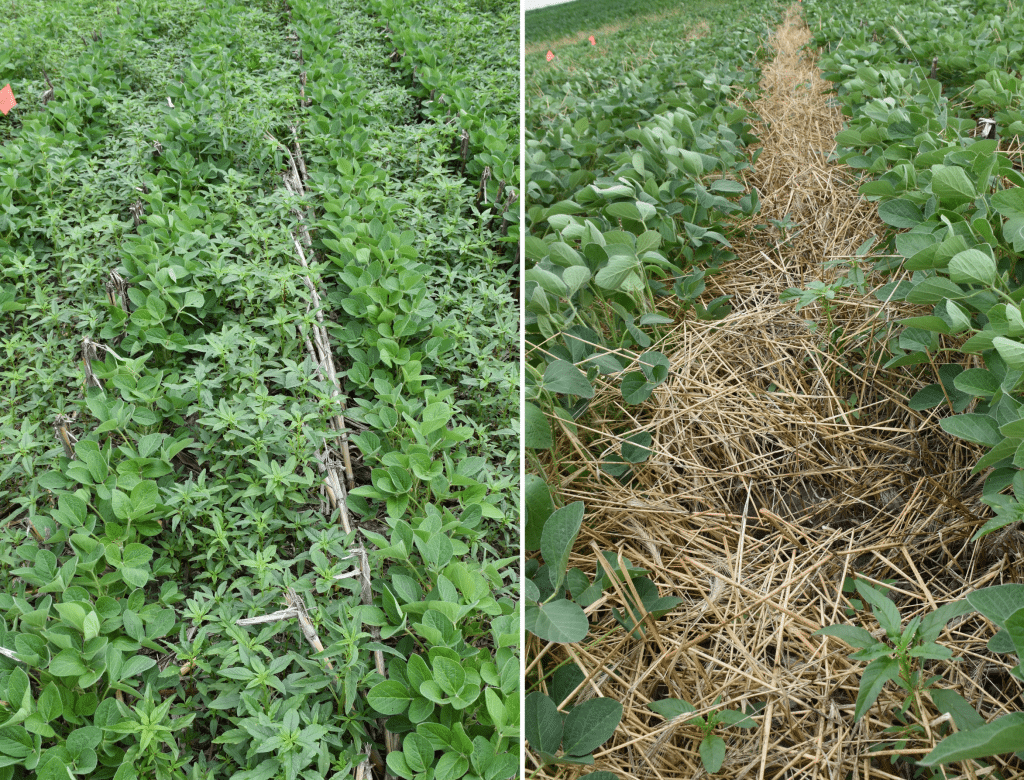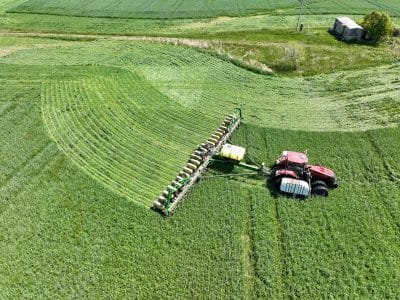It’s time to catch weeds by surprise. They know our herbicide habits pretty well, but what if farmers could start targeting them at completely different points in their life cycle?
That’s the goal of integrated weed management tactics – and my recent research from Iowa State University, which explores how combining cover crops, narrow row soybeans and year-over-year weed control can help farmers manage weeds more sustainably.

Little Hammers: Big Effects
Weeds progress through a series of stages, such as germination, establishment, growth, reproduction, dispersal, and dormancy, to complete the life cycle and persist in crop production systems. One must disrupt one or more of these stages to control weeds.
The mainstream weed control approach relies almost exclusively on herbicides or cultivation to disrupt germination and establishment stages. The adoption of other weed control tactics in crop production systems has been limited because on their own, they often provide only partial weed control. However, my research has shown the benefit of “many little hammers,” a term coined by Matt Liebman and Eric Gallandt in 1997, to explain how combinations of these tactics can provide weed control levels comparable with herbicides/cultivation.1
…[N]one of the “hammers” tested are likely to provide high levels of waterhemp control when used alone; however, their cumulative effect can provide high levels of waterhemp control and reduce the burden on a single hammer.
Ramawatar yadav
The “many little hammers” concept suggests stressing weeds at multiple sensitive points in their life cycles, which minimizes exposure to any one tactic and consequently the rates at which weeds become resistant to the tactics. This concept has received little attention in the last 25 years, but the dwindling efficacy of herbicides due to the widespread increase in herbicide-resistance makes it evident that the ‘many little hammers’ approach is essential to overcome the herbicide-resistance menace.
My recent study published in the journal Weed Science sheds light on how the ‘many little hammers’ can be utilized to manage herbicide-resistant weeds in crop production fields2. I used three little hammers, namely adequate weed control (more than 90%) in the prior year’s crop, a cereal rye cover crop, and narrow-row soybeans that spanned over two years to manage herbicide-resistant waterhemp – the most troublesome weed in the US Midwest corn and soybean rotations.
How The “Little Hammers” Worked
I started with an aggressive herbicide program with three sites of action in the prior year’s corn crop to achieve adequate waterhemp control and prevent seeds from returning to the soil seedbank for the following year’s soybean crop. Adequate waterhemp control in corn reduced waterhemp population density and biomass in soybean by more than 26% compared with inadequate waterhemp control (30%) in corn. This emphasizes the need to look after weed escapes that might not reduce crop yields but can increase weed infestation in the following years’ crops.
The next little hammer was a cereal rye cover crop drilled into corn stubble after harvest in the fall and terminated the following spring. Soybeans were planted into standing cereal rye, which was terminated with glyphosate on the same day. Cereal rye was at the anthesis stage, about three feet tall, and had a biomass of 4,600 lb/acre at the time of termination. A preemergence herbicide (S-metolachlor) was also applied at termination to provide early-season weed control. No other herbicide application was made to the plots. This thick mat of cover crop alone reduced waterhemp biomass by 63% compared with no cover crop.

The third hammer was introduced when soybeans were planted in narrow rows (15 inches) compared to the standard wide rows (30 inches). Narrow-row soybeans alone reduced waterhemp biomass by 30% compared with wide-row soybeans. Additionally, narrow-row soybeans produced 14% higher grain yield than wide-row soybeans.
Overall, the combination of all three hammers – adequate waterhemp control in the prior year’s corn, cereal rye cover crop, and narrow-row soybeans – reduced waterhemp biomass by 80% and seed production by 85% at the time of soybean harvest.

This indicates that none of the “hammers” tested are likely to provide high levels of waterhemp control when used alone; however, their cumulative effect can provide high levels of waterhemp control and reduce the burden on a single hammer. Additionally, other studies3,4,5 have reported that all of the three tactics discussed here can potentially increase herbicide effectiveness in managing troublesome weeds.
See more from GROW on managing weeds with cover crops and narrow soybean rows.

Text and photos by Ramawatar Yadav, Iowa State University
Citations
1Liebman M, Gallandt ER (1997) Many little hammers: ecological management of crop-weed interactions. Pages 291–343 in L. E. Jackson, ed. Ecology in Agriculture. San Diego, CA: Academic.
2Yadav R, Jha P, Hartzler R, Liebman M (2023) Multi-tactic strategies to manage herbicide-resistant waterhemp (Amaranthus tuberculatus) in corn–soybean rotations of the U.S. Midwest. Weed Science 71:141–149.
3Hartzler R, Roth G (1993) Effect of prior year’s weed control on herbicide effectiveness in corn (Zea mays). Weed Technology 7(3):611–614. https://doi.org/10.1017/S0890037X00037428
4Wallace J, Curran W, Mortensen D (2019) Cover crop effects on horseweed (Erigeron canadensis) density and size inequality at the time of herbicide exposure. Weed Science 67(3):327–338. https://doi.org/10.1017/wsc.2019.3
5Young B, Young J, Gonzini L, Hart S, Wax L (2001) Weed management in narrow- and wide-row glyphosate-resistant soybean (Glycine max). Weed Technology 15(1):112–121. https://doi.org/10.1614/0890-037X(2001)015[0112:WMINAW]2.0.CO;2





























































































